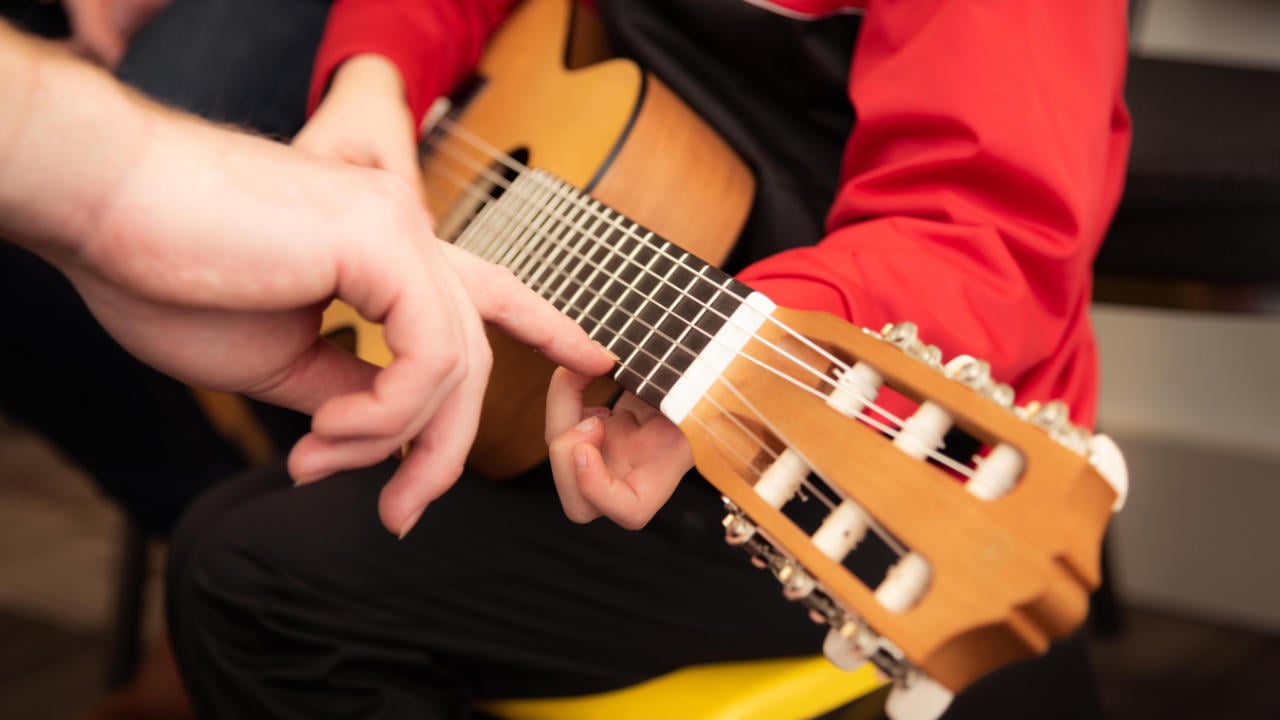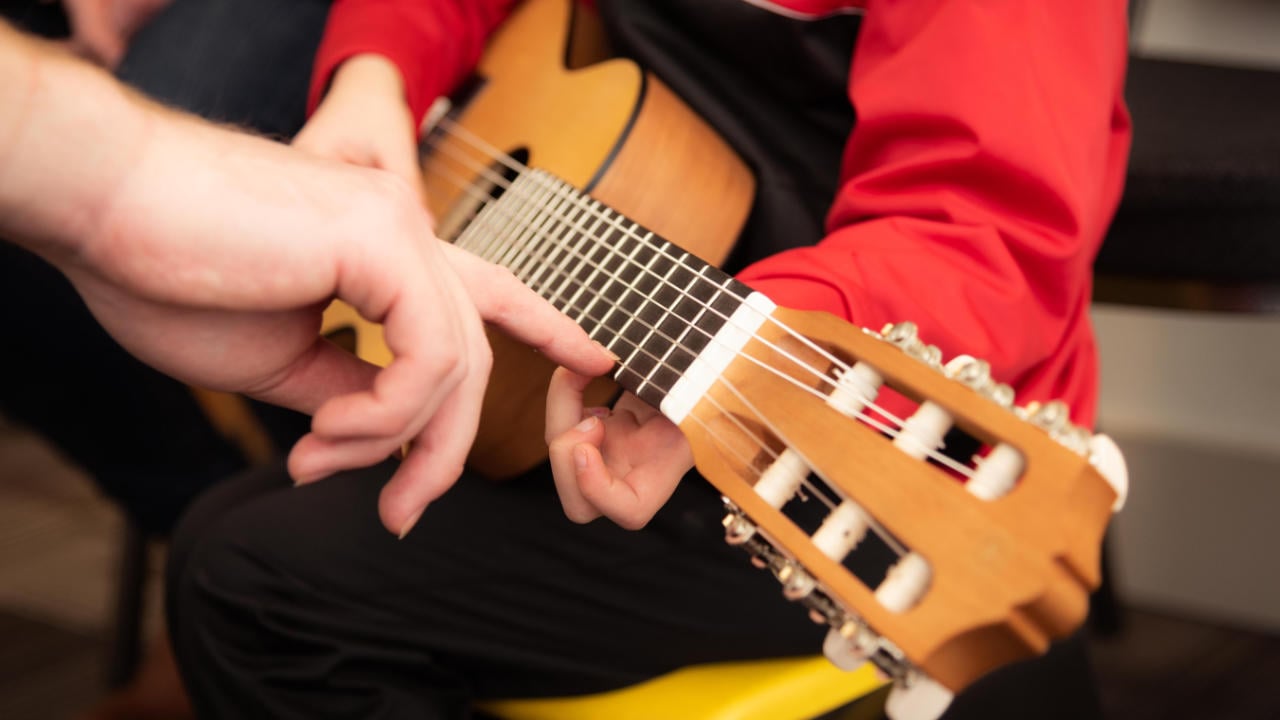There is an elegance and beauty to the classical guitar, unlike any other instrument. I love the silky-smooth sounds that you can produce from it. There are many pieces written or arranged for the guitar to sit very comfortably under the fingers. With a little practice, they are not hard to perform. However, some pieces can be extremely difficult to perform. Some instructors and promoters of the instrument can confuse difficulty with beauty. This should not be the case. Difficulty does not equal beauty. Easier pieces can be beautiful as well. Even in the harder pieces, playability can come down to how we think about the chords.

Rest Stroke, Free Stroke, Ego Stroke
You may have heard someone say something like “Romance” is a very simple beginner piece. Then they proceed to play only the first half of it while completely ignoring the B part. The first half, the A section, of the piece is simple. However, the second section is more “intermediate” in difficulty. Once you can play it fluently, you have stepped up your playing.
You may have heard it said that “Jesu, Joy of Man’s Desiring” is a beginner piece as well. It is one of my favorite Bach pieces on the guitar. So much so that I have arranged it with open triads. More on those later. I once posted a video of this version to a social media group. Almost immediately someone came back with, “Oh, this is just a beginner piece.” Really?
Here is the point (please forgive me for a bit of a rant). People who love to get online and down any piece they think is below them are simply stroking their ego. Ignore them. It is better to ask: was the piece played beautifully? It is better to appreciate the time and effort put into the piece than putting down someone else’s effort. I have heard many “basic beginner” pieces played beautifully. And I can appreciate the time and effort someone has put into learning, recording, and posting a video as well.
The Flip Side
Then there is the flip side. Sometimes the professional guitarist school of thought says if you’re not playing super complex chords, you’re not an advanced player. I call these chords the “break-your-hand” chords. Those are the chords where it is nearly impossible to play. They’re not always practical. After a lifetime of playing, the guitarist ends up with hand injuries such as Carpal Tunnel.
An important note here: if your hand is in pain – Stop playing. Stretch your hand and fingers. Playing through the pain could cause damage to your hand.
God only made your hand to stretch so far. I have a good five-fret stretch, but that is because of a hand injury received in a car wreck. Teaching the hand to stretch is a good thing, done properly. It is good to warm up the hands before playing. This decreases the chance of creating a hand injury. However (Ima gonna use that word a lot), pushing awkward hand positions is begging for trouble. Also, it is not good for your ego to push players into something that might cause them injury.
What To Do? What To Do?
Then there are the pieces written with these “impossible” chords that stroke people’s egos. I should not call them “impossible” chords. They are possible, just not well thought out. The only reason the composer/arranger uses them is that they didn’t explore the other options. Or they don’t understand how the fretboard works. Okay, rant over. Let’s think practically about chords.
What are the other options? I’m glad you asked. (You did ask, right? Well, even if you didn’t I’m gonna suggest some anyway):
One option is to simplify the chord in the piece. You can do this by dropping a note. It is an established convention that the 5th is not as valuable as the 3rd or the root. The 5th is very underappreciated at times, but you can cut him loose if needed. Poor 5th.
Another option is to revoice the chord. Be careful doing this in an established piece. Watch the bass note. However, you surely can do it in a composition or arrangement. You should be careful to consider the voice leading. Thinking it through could lead to some interesting and playable chords.
A third option is an open-triad. You can simplify complex chords into open triads. I love open triads. They’re so useful. I like adding them to “simpler” pieces. It tends to “fill them out.” Once I struggled with how many notes do you play to make a chord sound full without overdoing it. Do you play four, five, or six notes? As it turns out, three-note chords work very well on the guitar. They seem to be very balanced. Of course, you are not limited to open triads. Use the chord that is best for the song.
Bonus Option
A bonus option (just for you, really, just you) is to move the chord somewhere else on the fretboard. You can revoice the chord in the same position as the original chord. Or you could revoice the chord and/or move it to a different position on the fretboard. This is because notes are repeated in different positions on different strings. This also gives you a chance to simply move the chord to a more playable position.
Hard Does Not Mean Advanced
Being able to play “break-you-hand” chords does not necessarily make you an advanced, professional player. It could make you unwise. The more advanced player will know how to make the music work with accessible chords. An advanced player will understand the music. How it works, how it is put together. The advanced player will understand the mechanics behind the music. The advanced player/composer will make music accessible.
Hand Care
One last thought as I rant. If you want or need to play a challenging chord, consider taking care of your hands. Make sure that your hands are “warmed up.” You can do this by simple exercises, etudes, and even running your hands under warm water. Add a series of basic stretches to your warm-up each day. Work up to the harder stretches. Advance to something more difficult when you find that you can relax while playing the basic stretches. Taking care of your hands will lead to many years of beautiful playing.




Comments ()